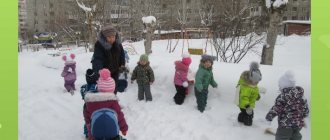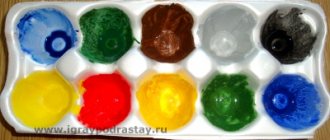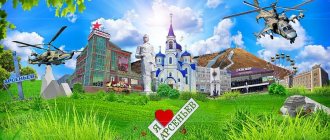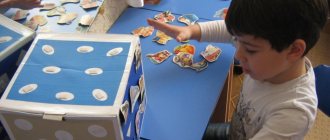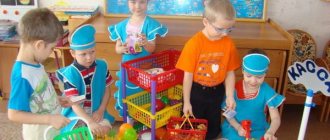Olga Andreeva
Card file of winter walks in the preparatory group
Observation #1
Observing changes in nature. Offer to look for signs of winter on your own.
Riddle: Powdered the paths,
I decorated the windows.
Gave joy to children
And I went for a sledding ride. (Winter)
Didactic game “Who is bigger?”
- practice selecting definitions for nouns.
What words can you use to describe winter? What's winter like? (magical, fairy-tale, snowy, frosty, blizzard, sparkling, magical winter, cold, beautiful, etc.)
Monitoring seasonal changes
Goals:
• form ideas about changes in nature at the beginning of winter (the night becomes longer and the day decreases)
;
• learn to distinguish the characteristic signs of the beginning of winter, recognize them in poems.
Bottom line
Educator: Guys, did you like our meeting with nature today?
What did you like? What new things have you learned? What have you learned? Why were you surprised? We have not yet revealed many secrets of nature, many surprises await us ahead. But “Winter” has prepared another little surprise for us. Do you think this surprise is for one or for all? But you need to find it, and the arrow pointers will help you with this. And when you find it, don’t forget to call all the guys so that they can see it too (the guys find sweet gifts in the chest).
Author: Ibragimova Gyuzeliya Nailovna Position: teacher of the highest qualification category Place of work: MBDOU kindergarten No. 71 in the city of Kostroma Location: Kostroma city, Mr. Davydovsky 2
Date modified: 09/13/2019
Experimenting and experiences while walking in winter
Preschool age is characterized by a special interest in the world around us. Often, a child cannot notice some fundamental things on his own, so it is important for a teacher to teach him not only to look, but also to see. Theoretical knowledge should be supported by visual material and experiments that can enrich children’s knowledge.
Experimentation on walks is divided into two types:
- Frontal - when children have several objects to observe and compare independently. For this type of observation, it is recommended to have two teachers monitoring the students, especially if the group is large.
- Demonstration - the teacher holds in his hands the object that has been selected for teaching. The teacher demonstrates the object and conducts an educational conversation. This method dampens initiative and activity; as a rule, preschoolers are not very interested in activities in which they must only observe without participating.
Quickly teach children how to count examples within 10 and 20
Important! Experiments that will be conducted with children must be selected in accordance with their development and age.
Experiments for preschoolers are not entertainment, but a way of teaching children, their acquaintance with the environment and life. Such walks can be done in the format of an open lesson, with the invitation of parents.
MAGAZINE Preschooler.RF
“How do you know winter?” Open demonstration of the walk in the preparatory group(Children get dressed and go outside)
Educator: “Come in, kids: Both girls and boys! I ask everyone to stand in a circle - take each other’s hands!
Look at each other and give smiles! I didn’t come to you alone - I brought guests to the site!
Say hello, guys (children say hello)
(A letter is brought out, the teacher reads):
- Hello, preparatory group guys! Employees of a research institute are writing to you. We are studying the Arctic and the characteristics of the winter season. On December 17, an international conference on this issue began in Moscow. Research by scientists on studying the characteristics of winter in desert, steppe, and middle zone conditions was presented. But unfortunately
no one presented studies of the characteristics of winter in the North. The institute staff found out that you guys live in the north and invite you to take part in the conference.
Educator: Guys, do you agree to take part in the conference (Yes)
-How can you and I take part in the conference and talk about our northern winter?
Children: Draw, go, fly.
Educator: Let's draw and send the drawings by mail, it will take a long time! Let's go by train - everyone will want to go, there may be no tickets! By plane - expensive!
-What do we do? After all, you know so much about our winter (Bring the children to the conclusion that you can shoot a video and send it) You have watched so many programs and films about different seasons on TV. Let's try to make a movie ourselves! Tell me the professions of the people who participate in the creation of the film (children's answers)
Educator: Guys, fortunately for us, I have a familiar cameraman who will help us shoot a film, edit it and send it to Moscow (a cameraman appears with a camera)
Educator: Guys, are you ready to tell the conference participants about our northern winter (Yes) Then answer loudly, clearly, in a complete sentence!
- What time of year is it now in the North?
- What signs of winter do you know?
- What are the winter months?
- What kind of winter do we have in the North?
- How are animals ready for winter?
- How do trees winter? Why are trees dormant in winter? Why can't you shake snow off branches? What can we do to prevent tree roots from freezing? Let's ask our boys to brush the roots of the trees (The boys take shovels and brush the tree trunks on the site)
- (addressing the girls) Why are there few birds outside in winter? What birds stayed with us for the winter? What do you and I do to help birds in winter? Let's pour grain into our feeders (together with the girls we pour grain into the feeders, then, after finishing the work, the girls praise the boys, the boys praise the girls)
- What games and fun do children play in winter (children's answers)
(a low-mobility game is played, children perform movements according to the text)
“Winter has finally come! The houses have become white! It's snowing outside, the janitor is sweeping the street!
We go sledding, make laps on the skating rink, deftly ski, and all play snowballs! "
Educator: Well done, guys! And you also want to play (Yes). But first, let's remember the rules of safe behavior on the site during games. (children's answers)
(A game of medium mobility is played “Hit the target.” Children are divided into two teams, each pair throws snowballs at the target).
Educator: Now, guys, guess my riddle!
"Transparent like glass,
Don't put it in the window! "(ice)
-You will find out if you guessed correctly if you read the inscription in the ice secret (Children take the “secrets” - pre-frozen water in small bowls, in which there are pieces of paper with the inscription “ice”, read; it means the riddle was guessed correctly)
Educator: (experimental activities are being carried out to identify the properties of ice) Guys, can you clearly see the inscription? Were you able to easily read the word “ice”? So, what conclusion do we draw?
Children: The ice is transparent, you can clearly see everything through it!
Educator: Stroke the ice with your hand. What are they like (smooth, slippery)
Educator: Now let's try to get some pieces of paper. What needs to be done for this (break the ice) So what kind of ice is it (breakable, fragile)
Educator: What do you think is easier: water or ice (Children throw pieces of ice into a bowl of water and find out that pieces of ice do not sink, which means they are lighter than water)
Educator: And also, guys, ice can be dangerous! Why ice is dangerous (answers)
-Well done boys! You correctly named all the properties of ice, I think the institute staff remembered everything! What would our northern winter be like without a snowman (children perform movements according to the text)
“Tra-ta-ta, tra-ta-ta, we’re making a snowman! We will put the com on whom. Let's draw eyes, insert a carrot nose. We'll find the hat.
What a white, fat snowman! "
(Snowman appears)
Snowman: Hello guys! The magpie told me that you are filming a movie here! I want to participate too! Who knows everything about winter if not me! This is my favorite time of year! The magpie told me that you told and showed a lot here! And I myself want to make sure that you know everything! Here's your first task:
1) Select words related to the meaning of the word “snow”: “Quietly, quietly, as in a dream, it falls to the ground. (snow) All silvery fluffs are sliding from the sky. (snowflakes) This is fun for the guys - it's getting stronger. (snowfall)
It’s like he’s dressed up in a white down jacket. (snowman)
In the snow, look, with a red breast. (bullfinches)
Task 2:
-Which is more: snowfalls or snowflakes?
-Which is less: winters or winter months?
Snowman: Well done, guys! I see that the magpie did not deceive me!
Educator: Snowman, do you want to play with us (The outdoor game “Snowman” is played, the children choose a leader with a counting rhyme)
“The snowman is sitting, sitting.
He dozes in the morning and sleeps during the day.
In the evenings he waits quietly, at night he comes to scare everyone! "(2-3 times)
Snowman: Guys, thank you for the game, but it’s time for me to leave! I brought you a winter treat - snowballs as a gift, but you eat them after a walk in the group (leaves) Teacher: Well, guys, it’s time for us to finish our film! Let’s say “thank you” to our cameraman; today he will edit everything and send our film to the conference participants, who will watch it today!
(The guests leave, the walk continues)
| Next > |
